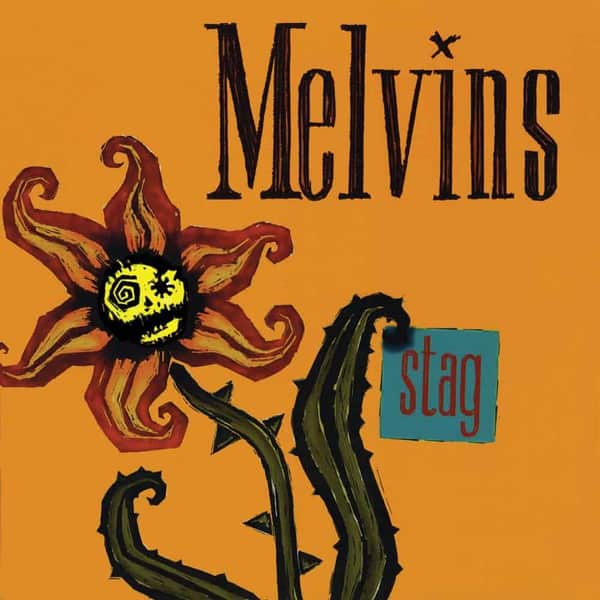Heavy, Weird, and Absolutely Brilliant
Why this 1996 Melvins' release stands as one of the band’s most daring efforts
The last three days, I found myself in a long-forgotten state. I hadn’t been this sick in over three years. It seemed like an ordinary virus, but for some reason, it really knocked me out, especially at night. During the day, there was work (after all, who takes sick leave when you mostly work remotely?), but the second night was the worst. My body was wrecked by fever, like I was some kind of Burroughs character, going cold turkey after an overdose. Naturally, listening to music was out of the question. I simply couldn’t. Bits and pieces of random podcasts played in the background, but everything blended into a confusing mess in my head.
Then, just before dawn on the third day, I finally managed to sleep a couple of hours. And I even dreamed normally for once. The best part? My dream was soundtracked by Stag, the brilliant album by Melvins. A fitting climax to the most miserable period of this flu.
Stag (released in 1996) followed the genius, legendary (choose your own adjective) Houdini, and has long remained in its shadow. But in many ways, I love Stag even more—and here’s why.
Stag is one of those albums that doesn't reveal all its layers on the first listen. Released in 1996, following the colossal success of Houdini, it often remains overshadowed by its predecessor. Houdini was, and still is, a milestone in Melvins’ career—a raw, sludgy masterpiece that cemented their place in alternative rock and metal history. But Stag? It’s a different beast entirely, and perhaps it’s for that very reason that it holds a special place in the hearts of those willing to dive deep.
The opening track, “The Bit”, sets the tone for the entire album. From the very first seconds, it grips you with a towering, hypnotic riff that pulls you into a dark, swirling sonic landscape. The riff is thick, foreboding, and strangely exotic, immediately giving the sense that this isn’t going to be a straightforward sludge metal record. It sounds like a distorted Middle Eastern sitar, bending and twisting in ways that feel unsettling but exciting. It’s this riff that lets you know Melvins are about to take you on a journey far beyond the predictable.
The genius of “The Bit” lies not only in its riff but in the way it shifts dynamics. It moves between moments of sheer heaviness and spaces of unsettling calm, creating tension and release in a way that feels masterful. Buzz Osborne’s guitar work, as always, is both primal and intricate. The song feels like a statement—Melvins are not just recycling the sludge-heavy riffs that made them famous. They are experimenting, pushing boundaries, and evolving, whether or not everyone is ready to follow.
As the album unfolds, this spirit of experimentation becomes even more apparent. Stag blends elements of noise rock, psychedelia, jazz, and avant-garde with their signature sludge sound. Tracks like “Tipping the Lion” and “Captain Pungent” are quirky and unpredictable, showcasing the band’s willingness to veer into absurdity while maintaining a strange cohesiveness. At times, Stag feels like a collage of disparate ideas, yet somehow, it all works.
And yet, despite its eclecticism, Stag doesn’t abandon heaviness. Songs like “The Bloat” and “Buck Owens” deliver thick, slow-moving riffs that anchor the album in the sludgy depths Melvins are known for. But these moments of crushing weight are balanced by the unexpected: lush acoustic passages, eerie soundscapes, and even bursts of jazzy, off-kilter rhythms. The album is constantly shifting, refusing to be pinned down by any one genre or expectation.
While Stag might seem like a departure from the heavy, straightforward sludge metal that Melvins are best known for, it still retains the unmistakable stylistic trademarks that define the band’s sound. Throughout the album, the thick, distorted riffs, the pummeling rhythms, and Buzz Osborne’s unmistakable vocal delivery ground the experimental elements in the classic Melvins’ sludge. In that sense, Stag might not be as revolutionary or groundbreaking as some of their earlier works, but it doesn’t need to be.
What Stag offers is a solid, cohesive entry into Melvins’ discography that shows a band confident in their sound yet still willing to push at the edges of their comfort zone. While the album isn't necessarily bursting with novelty, it refines and deepens the band’s existing approach, making it a worthy and compelling listen for fans of their previous albums. In the end, Stag might not be trying to reinvent the wheel, but it’s definitely showing us a wheel that spins faster and heavier than ever before.
In hindsight, it’s clear that Stag was ahead of its time. While it didn’t achieve the same level of recognition as Houdini, it has grown in stature over the years, as more and more listeners discover its genius. It’s an album that refuses to be pigeonholed, combining crushing heaviness with surreal experimentation. It’s a reminder that Melvins are, and always have been, a band that defies categorization.
With “The Bit” as its opening salvo, Stag invites listeners into a strange, dark world of unexpected twists and turns. The riffs are massive, the experimentation bold, and the results unforgettable. For those of us who have lived through the fever dream of life and music, Stag serves as the perfect soundtrack—a reminder that, sometimes, the best art comes from moments of chaos and unpredictability.



